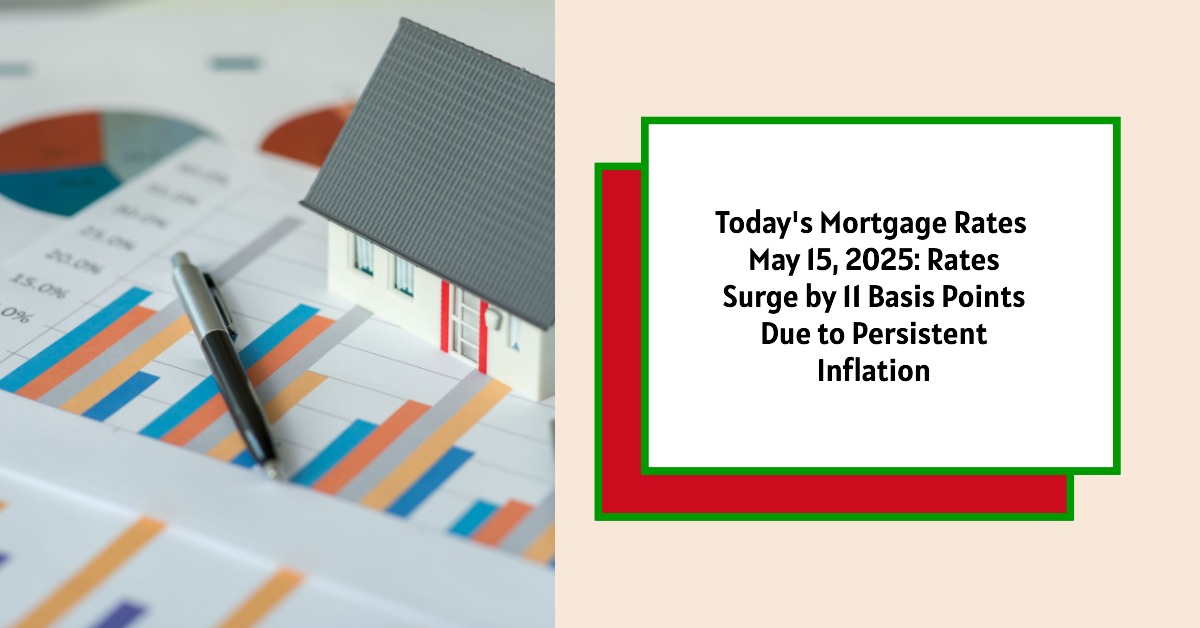As of May 15, 2025, today's mortgage rates have seen a notable increase due to ongoing inflation concerns. The average interest rate for a 30-year fixed mortgage now stands at 6.87%, while the 15-year fixed mortgage rate has climbed to 6.12%. These changes reflect a combination of economic factors impacting borrowing costs. Homebuyers and those looking to refinance should pay close attention to these trends as they can significantly influence financial decisions related to home ownership.
Today's Mortgage Rates – May 15, 2025: Rates Surge by 11 Basis Points Due to Persistent Inflation
Key Takeaways:
- Mortgage Rates Increase: The 30-year fixed rates have risen to 6.87%, up from previous weeks.
- Refinance Rates Also Rise: The average refinancing rate for a 30-year mortgage is now 6.89%.
- Impact of Inflation: The latest Consumer Price Index indicates inflation rose 2.3% year-over-year, affecting housing costs.
- Federal Reserve's Position: Uncertainty remains regarding future rate cuts due to potential inflation changes influenced by tariff agreements.
- Economic Outlook: Variations in economic indicators are likely to influence mortgage rates in the coming months.
Understanding Today's Mortgage Rates
This week's uptick in mortgage rates can be attributed to persistent inflation concerns that continue to shape the financial landscape. In May 2025, the average 30-year fixed mortgage rate jumped by 11 basis points, and the 15-year fixed mortgage rate surged by 23 basis points (Tarpley, 2025). This significant change indicates that prospective borrowers are facing higher costs for new loans and refinancing options, which could slow down the housing market's overall growth.
| Mortgage Type | Interest Rate |
|---|---|
| 30-year fixed | 6.87% |
| 20-year fixed | 6.57% |
| 15-year fixed | 6.12% |
| 5/1 ARM | 7.35% |
| 7/1 ARM | 7.44% |
| 30-year VA | 6.37% |
| 15-year VA | 5.82% |
| 5/1 VA | 6.55% |
Source: Zillow
As reflected in these figures, the rates for loans backed by the VA are slightly lower compared to conventional loans, which may provide an opportunity for eligible borrowers to benefit from reduced borrowing costs.
Furthermore, while analyzing mortgage trends, it is essential to recognize how external factors, such as recent tariff agreements between the U.S. and China, can create instability. This news has not only influenced investor sentiment but has also fueled fears of rising inflation, leading to an increased cautious stance from borrowers.
Detailed Look at Refinancing Rates
Homeowners considering refinancing should take note that, as of May 15, 2025, average refinance rates have increased similarly to purchase rates:
| Refinance Type | Interest Rate |
|---|---|
| 30-year fixed | 6.89% |
| 20-year fixed | 6.55% |
| 15-year fixed | 6.22% |
| 5/1 ARM | 7.42% |
| 7/1 ARM | 7.12% |
| 30-year VA | 6.45% |
| 15-year VA | 6.07% |
| 5/1 VA | 6.21% |
Source: Zillow
The rise in refinance rates can often lead to confusion among homeowners wanting to take advantage of lower payments or to access their home equity. Unlike purchase mortgages, refinance rates can sometimes be higher due to lender perceptions of risk and market conditions. Therefore, homeowners are encouraged to evaluate their options continuously, as rates can change frequently.
What Influences Mortgage Rates?
Understanding how mortgage rates are determined is crucial for anyone navigating the home buying or refinancing process. Several factors play a significant role:
- Credit Scores: Lenders provide better rates to borrowers with higher credit scores, as these individuals are viewed as lower risk. Maintaining a good credit profile through timely payments and low credit utilization can improve your chances of securing a favorable mortgage rate.
- Economic Indicators: Metrics such as employment rates, inflation, and GDP growth significantly sway mortgage rates. When the economy is struggling, rates may drop to encourage borrowing. Conversely, in a booming economy, rates may rise to prevent overheating.
- Federal Reserve Decisions: Although the Fed does not set mortgage rates directly, its monetary policies greatly influence financial markets. For example, if the Fed raises interest rates to curb inflation, mortgage rates typically follow suit.
- Bond Markets: Mortgage rates are closely tied to treasury yields; thus, when bond prices fall and yields rise, mortgage rates generally increase. This relationship is pivotal for homebuyers and those looking to refinance.
- Market Competition: The level of competition among lenders can lead to lower rates for borrowers. When multiple lenders vie for business, they may offer promotional rates to attract buyers.
Types of Mortgages Explained
When considering the available mortgage options, it is important to understand the distinctions between different loan types:
- Fixed-Rate Mortgages: These loans offer a stable interest rate throughout the life of the loan, making budgeting much easier for homeowners. For many, the predictability of fixed-rate mortgages plays a significant role in their decision-making process, especially given the current market volatility.
- Adjustable Rates (ARMs): ARMs offer lower initial rates but come with the risk of fluctuating rates after an initial fixed period. For example, a 5/1 ARM maintains a fixed rate for the first five years, after which the rate adjusts annually. While ARMs can initially provide savings, borrowers must be cautious about the potential for rising payments once the adjustment period begins.
Read More:
Mortgage Rates Trends as of May 14, 2025
Dave Ramsey Predicts Mortgage Rates Will Probably Drop Soon in 2025
Future of Mortgage Rates Post-Fed Decision: Will Rates Drop?
Fed's Decision Signals Mortgage Rates Won't Go Down Significantly
Current Economic Outlook
Looking towards the future, both Fannie Mae and the Mortgage Bankers Association continually assess economic trends. Their latest forecasts suggest a cautiously optimistic outlook for 30-year fixed mortgage rates, but uncertainty remains. The following table illustrates projected rates:
| Forecaster | Q2/25 | Q3/25 | Q4/25 | Q1/26 |
|---|---|---|---|---|
| Fannie Mae | 6.5% | 6.3% | 6.2% | 6.1% |
| MBA | 7.0% | 6.8% | 6.7% | 6.6% |
The projected decline by organizations like Fannie Mae indicates a belief that inflation pressures may ease later in 2025, as economic indicators begin to stabilize. However, predictions are inherently uncertain due to the many unpredictable factors influencing the economy. As such, borrowers should remain informed and keep abreast of the latest market conditions.
The Future of Mortgage Rates
The interplay between mortgage rates and the broader economy will continue to impact homebuyers and homeowners alike. With the current rise attributed mainly to inflation fears, it is crucial for anyone in the market to remain informed about ongoing economic developments.
While it may be tempting to wait for rates to drop, individuals must consider their unique circumstances, such as how long they plan to stay in their home or whether they can afford a potential increase in payment over time. Given that current rates are fluctuating, timing may play a significant role in one’s decision to lock in a mortgage.
Further developments in economic policy and international relations may shift mortgage rates further, especially if inflation is exacerbated by external factors like tariffs. The volatility in housing costs reinforces the need for buyers and homeowners to approach the market strategically.
In essence, today’s mortgage rates reflect the complex dynamics of inflation, economic forecasts, and lending risk. Staying educated will empower potential homeowners to make informed decisions in a fluctuating market.
Invest Smarter in a High-Rate Environment
With mortgage rates remaining elevated this year, it's more important than ever to focus on cash-flowing investment properties in strong rental markets.
Norada helps investors like you identify turnkey real estate deals that deliver predictable returns—even when borrowing costs are high.
HOT NEW LISTINGS JUST ADDED!
Connect with a Norada investment counselor today (No Obligation):
(800) 611-3060
Also Read:
- Will Mortgage Rates Go Down in 2025: Morgan Stanley's Forecast
- Expect High Mortgage Rates Until 2026: Fannie Mae's 2-Year Forecast
- Mortgage Rate Predictions 2025 from 4 Leading Housing Experts
- Mortgage Rates Forecast for the Next 3 Years: 2025 to 2027
- 30-Year Mortgage Rate Forecast for the Next 5 Years
- 15-Year Mortgage Rate Forecast for the Next 5 Years
- Why Are Mortgage Rates Going Up in 2025: Will Rates Drop?
- Why Are Mortgage Rates So High and Predictions for 2025
- Will Mortgage Rates Ever Be 3% Again in the Future?
- Mortgage Rates Predictions for Next 2 Years
- Mortgage Rate Predictions for Next 5 Years
- Mortgage Rate Predictions: Why 2% and 3% Rates are Out of Reach
- How Lower Mortgage Rates Can Save You Thousands?
- How to Get a Low Mortgage Interest Rate?
- Will Mortgage Rates Ever Be 4% Again?



